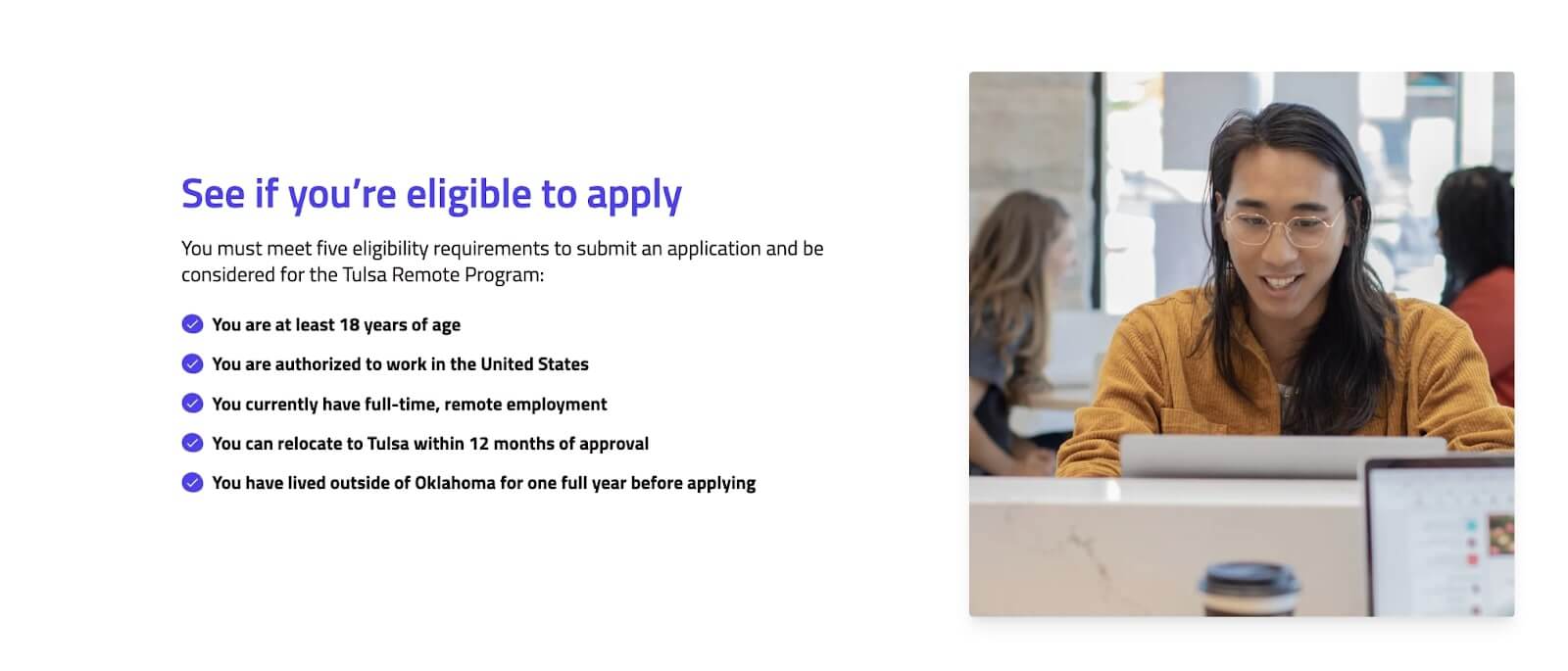Relocation Guide for Remote Workers in the US
Relocating as a remote worker can be an exciting opportunity to explore new places and experience different environments while maintaining your job. After all, being able to work from anywhere means you can choose the best place for you to thrive!

Relocating as a remote worker has a lot of benefits like exploring different cities or regions that align with your lifestyle and interests or immersing yourself in new communities, meeting diverse people, and even expanding your professional network. Plus, relocating can provide a fresh start and a chance for personal growth, as you adapt to new environments and embrace new experiences.
Sounds great, right?
But it can also be challenging if you don’t even know where to start or what you have to consider to make a move.
In this guide, we’re talking about the steps you need to consider if you want to relocate as a remote worker.
Follow along and start planning your move! 🚗
✔️ Take advantage of a relocation program
But before we jump into the guide, let’s talk a bit about relocation programs. A relocation program is a service or assistance provided by employers or third-party providers and their goal is to help you relocate, obviously. The great thing about these programs is that they’re specifically designed to help remote workers have a smooth and successful relocation experience. Benefits range from financial assistance to guidance in finding housing or communities.
Here are some of the benefits of choosing a relocation program instead of relocating by yourself:
- Financial assistance: Many relocation programs offer financial assistance to help cover different expenses.
- Housing support: Relocation programs often provide support in finding a new home in your new destination.
- Community integration: One of the best benefits of relocation programs is that they offer resources and tons of opportunities to integrate into the local community, like events, networking opportunities, and connections to people who have made the move before. This way, you can feel like you belong faster.
- Access to resources: most relocation programs provide access to resources so you can feel at home faster, like information about local services, amenities, and even schools.
- Networking opportunities: By participating in a relocation program, remote workers have the chance to connect with other professionals in their field who have also relocated. This can expand their professional network and create potential collaboration or career advancement opportunities.
- Support: having people by your side who have gone through the same and who are interested in helping you through the whole process is one of the biggest benefits of applying for a relocation program. Everything will go smoother!
So, now that we’re on the same page about relocation programs, let’s jump into the guide! 🗒️
✔️ Choosing the Best Relocation Program
First comes the most important part: choosing the best relocation program for you. There are a lot of programs out there so here’s how you can start choosing what’s best. The most important part is that you find something that aligns with your needs and your preferences. After all, you’re moving to be in a better place, it has to check all your marks!
1. Make a List of Your Preferences
Take into account your personal preferences. These are some important things you have to consider:
- Location
- Climate
- Cost of living
- Housing
- Quality of life
- Amenities
- Healthcare facilities
- Educational institutions
- Social opportunities
- Region type
2. Research, Research, Research
Start by researching all relocation programs you can. You can use online platforms that provide information on the best relocation opportunities. They can offer valuable insights into popular destinations for remote workers. There you can even filter out options depending on what you’re looking for.

3. Check Requirements
All programs have different requirements and you need to read those carefully to make sure you check all the marks the program requires. Things like having a remote job or being able to move within a timeframe are common requirements.
4. Seek Recommendations
Reach out to fellow remote workers or colleagues who have relocated or used any of the programs you discover. They will be able to provide insights and recommendations based on their own experiences.
5. Connect With the Programs
Nowadays, it’s super easy to connect with the people behind programs like these. Go on LinkedIn and reach out to people who can help you and answer all your questions.
By carefully considering all available options, you can choose a relocation program that aligns perfectly with your specific needs and preferences.
✔️ Applying for Relocation Programs
Once you’ve decided on the best relocation program, the one that fits your needs and the one you comply with all the requirements, then it’s time to start applying. We know a process like this can seem challenging but let’s break it down into small steps to make it easier!
1. Review the Program Guidelines
Start by thoroughly reviewing the program guidelines and eligibility criteria. Take note of any specific requirements, such as minimum remote employment status, age, or any specific documentation that you may need. Make sure that you meet all the necessary qualifications so that you don’t waste your time applying for any program. Also, be sure to understand what’s expected from you as a participant of the program, and that you’re ok with that.

2. Gather Required Documentation
Collect all the necessary documentation as outlined in the program guidelines. This may include proof of employment, identification documents, proof of address, or any other supporting materials required. Other programs also focus on how you’ll integrate into their communities so be prepared to answer questions about your social life or how you expect to add to the social life in the place you’re planning to move to.
3. Prepare a Strong Application
When applying for a relocation program, it is super important to present yourself in the best possible light. You’ll also want to showcase who you are and why you’d be a great addition to this program, show your personality, enthusiasm, and commitment to the opportunity! Remember that you’re thinking about making a move, which is not a small thing, so your application needs to be done with care and time.
4. Submit Your Application on Time
Some programs have application deadlines. Pay attention to those so that you submit your application on time! Late submissions may not be considered so it’s really important to plan and have enough time to complete and review your application with detail.
5. Follow Up if Necessary
After submitting your application, and just as you would do with a remote job application, it’s perfectly fine to follow up with the people you connected with during your application process. This will show you’re interested and that you’re proactive. Also, if someone has any questions about your application, you’ll be able to give some answers.
6. Be Prepared for Interviews or Assessments
Of course, many programs require interviews in person. This is a great opportunity for you to see the place by yourself and assess if you can picture your life there. It’s also great to know if you’ll get the support you need and if you enjoy the vibe of the community. Plus, the people involved in your process will be able to see you in person and how you fit into the program. It’s a win-win for everyone!
Remember these are general steps because each relocation program may have specific application requirements or processes, that’s why is crucial to carefully review and comply with all the instructions that the program provides. By preparing a strong application, submitting it on time, and following up when needed, you increase your chances of successfully securing a spot in the relocation program and embarking on a new exciting chapter in your remote work journey! 🚀
✔️ Preparing for the Move
Now, an essential part of the whole process is to prepare for the move. This is an exciting part of the journey because it means you’re on your way to start a new life, at a new, interesting place. If you’ve ever moved, you know it can be a long, frustrating process… but it doesn’t have to be! Consider these steps to start preparing your move, and start taking action.
Start Notifying Your Employer and Discuss Arrangements or Paperwork
One of the advantages of being a remote worker is that you have freedom to choose where you want to live but it’s always important to stay transparent with your employer. Have an open conversation with your employer to address any concerns, discuss potential changes in work arrangements, and make expectations clear. Plus, it’s always good to discuss if your relocation will mean that things will change for your contract, tax documentation, or even schedule.
Track Your Current Expenses
Before the move, track your current expenses for a few months to understand your spending habits (if you’re not doing it already). This will help you identify areas where you can potentially cut back or adjust your budget, in case you need it. Analyze your monthly bills, subscriptions, social expenses, and other spending to determine where you can start saving for your move.
Create a Moving Checklist
Make a detailed checklist of all the tasks you need to complete during the move. No task is small! This will help you identify potential expenses and ensure that you don't overlook anything important Include items such as packing supplies, moving company costs, utility connection fees, and address change notifications. This will add order to your ideas.

Research Housing Options
This is a critical step and here’s where a relocation program can help you because they can give you all the information you need to make the right choice.
Estimate Your Expenses
Start by estimating all the expenses you will have during the move. Consider everything from transportation, temporary accommodation if you need it, moving services, packing supplies, and any additional fees or deposits related to your new home. Here’s why it’s so important for you to do previous research, because if you did it correctly, you’ll already have an idea of how much you’ll spend in your new place of residence. Don’t forget to account for potential unexpected expenses, which always happen when you move.
Set Priorities
Once you have a better idea of what you have to do and what your budget is, you can start prioritizing. Decide which expenses are essential and which ones you can be more flexible with. Depending on what’s important to you, you can allocate more budget to a professional moving service instead of spending it on temporary accommodation, for example.
Review and Adjust
Regularly review your budget as you progress through the moving process. Adjust your estimates and expenses based on new information and changing circumstances. Always stay flexible and open to making changes to your budget to ensure that you stay on track.
By doing all of this, you can create a plan that allows for a smooth and financially manageable relocation experience. 👏
✔️ The Move
Now the fun part begins, the move! Here’s where your adventure starts to feel real because you’ll leave what you know behind and start a new experience in your life. By having planned everything to a T, you’ll already know what you have to do and how you have to do it. So let’s start from the beginning.
Determine a Timeline and Set Achievable Goals
Determining a timeline for your move is an essential step in ensuring a smooth and organized relocation process. Start by assessing your current situation and considering any external factors that may impact your timeline, such as lease agreements or employment contracts.
Once you have a clear understanding of your constraints, break down the relocation process into stages and set achievable goals for each stage. For example, you might set a goal to get to your new home on a specific date —also remember this constraint might come from the program, and then you can plan the rest around that date.
Setting realistic goals and creating a timeline will help you stay on track. You’ll just be checking off items from your list, which always feels exciting!
Secure Housing Options
Consider your budget and financial capabilities, and consider costs like utilities, maintenance fees, and deposits. Be ready to provide the necessary documentation like proof of income, identification, and references.
Some remote workers prefer to get to their new city and look for housing options in person, others prefer to get there and already have a secure housing option. Whatever your preference is, you need to account for that in your timeline.
Arrange Transportation of Your Belongings and Pack
There are several options available to help you move your belongings to your new destination. One common option is hiring a professional moving company. These companies specialize in packing, loading, and transporting your items safely and efficiently. If that’s within your budget, then you can go that way.

Another option is renting a moving truck or van and managing the move yourself. This option gives you more control over the process and allows for a more flexible timeline, which is always nice to have. Additionally, you can consider using shipping services to transport your belongings, especially if you have a smaller quantity of items or if you are moving all across the country.
Researching and comparing these different options will help you choose the one that best fits your needs, budget, and timeline for the relocation of your belongings.
Start Updating Your Address
Updating your address with relevant parties ensures that important documents, mail, and communications reach you at your new home. Here are some of the important parties you need to notify about your change of residence:
- Banks: notify your primary bank and any additional financial institutions where you hold accounts. Remember to update your mailing address for all relevant services, such as statements, credit cards, and other correspondence. This ensures that your financial information remains up-to-date and secure.
- Government agencies: start by updating your address with the United States Postal Service (USPS) through their online Change of Address service. This will forward your mail to your new address for a specified period. Additionally, update your address with agencies such as the Internal Revenue Service (IRS), Social Security Administration (SSA), Department of Motor Vehicles (DMV), and voter registration offices. Each agency may have different requirements and methods for updating your address, so visit their official websites or contact them directly for guidance.
- Subscriptions: Don't forget to update your address with any subscriptions or memberships you have, such as magazines, online services, or monthly deliveries.